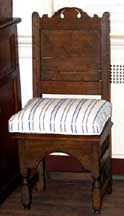Colonial Architecture................Colonial and Colonial Revival FURNITURE............ Illustrated FURNITURE Glossary
Furniture - Pilgrim / Colonial
Revival Pilgrim Style
Alternate name for Pilgrim: Jacobean style
1630-1690

Pilgrim
|
Essential elements: Turned columnar stiles and legs. Turned spindles. Broad slats. Some inset wainscot paneling. Seats: cane. rush, leather, or needlepoint. Tabletops made of wide heavy boards. Primary woods: Oak; sometimes maple or hickory for turned parts. Secondary woods: Pine, ash, maple, hickory, or others. Notable forms: Chairs: slat-back, wainscot, Carver, Brewster, and Cromwell. Joint stool. Simple bench. Tables: trestle-base and gate-leg. Chair-table. Low-post bed.
|
Pilgrim style is the American version of English Jacobean style, in vogue 1600-1690 during the reign of James I and his successors.
This earliest distinguishable American style was derived from Renaissance and 17th century English models. English furniture was massive, rectilinear, and usually made of oak. Since oak was plentiful in America, the English immigrant colonists used it to make similar forms. Pine was sometimes employed for concealed elements.
Like 17th-century English furniture, Pilgrim-style furniture (as it is called, although little of it was made by Pilgrims) is simple, strong, massive, and rectilinear.
Pilgrim style is primary a Renaissance style with some Baroque influence, although the rest of Western Europe, not suffering from civil war as was England, was enjoying lighter and more comfortable furniture.
Many case pieces are composed of grooved stiles and rails that form a frame into which panels are set. The panels usually have carved decoration. Many of these early pieces were painted, but few today have traces of their original paint. The most common case pieces executed in the Pilgrim style are chests and Bible boxes, and the massive court and press cupboards that only a few wealthy individuals could afford.
Tables were mainly trestle based or gateleg.
Chairs were comprised often of posts and spindles with rush seats or had hard slat backs. Typical was the Wainscot chair, which, with its solid back and columnar turned legs, was based on Elizabethan models.
- Illustration above: Wainscot chair - Fairmount Park Woodford House, Philadelphia
- Cupboard - Winterthur Museum
- Misc. Jacobean furniture - Reprinted from Edgar G. Miller, Jr., American Antique Furniture, 1937, Vols. 1 & 2
Colonial Revival: PilgrimIn the 20th century, a Colonial Revival in architecture and furniture took place, and Pilgrim style furniture was reproduced.
- Various pieces of Kittinger furniture, - Seymour H. Knox House / Blessed Sacrament RC Church Parish Office
- 3 wainscot chairs - Saturn Club
- Bench - Kittinger Furniture Company
